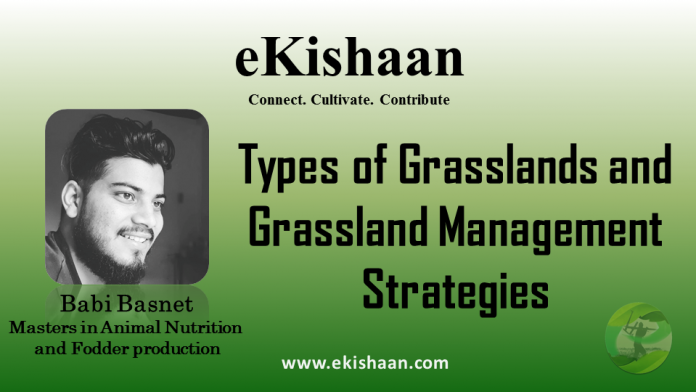Types of Grasslands and Grassland Management Strategies
Grasslands are areas where the vegetation is dominated by grasses. Grasslands cover around 40 percent of the earth’s surface, and they exist in both temperate and tropical regions.
Types of Grasslands:
- Natural Grassland
- Artificial grassland
Natural Grassland:
Grasslands under no or moderate human influence. Low productivity grasslands often situated in areas of rough, uneven ground, steep slopes; frequently including rocky areas or patches of other (semi) natural vegetation. Natural grasslands are areas with herbaceous vegetation covering at least 50% of the surface. Besides herbaceous vegetation, areas of shrub formations, of scattered trees and of mineral outcrops also occur. The grassland in which the plant communities have perennial grass as dominant species. However, trees are completely absent.
Main factors determining such grassland
- Determined by the extreme climate.
- Low moisture availability.
- Get just enough precipitation.
- Found between desert and forest or at the rain shadow of mountains.
Artificial Grassland:
These are the grassland of more recent origin. They have been formed by destroying forest mainly by cutting and fire. These have been maintained largely through grazing animals.
Main factors determining such grasslands
- Climatic factors: Precipitation, Temperature, Humidity
- Edaphic factors: physical and chemical properties of soil
- Biotic factors: influenced by: Fire, Grazing and land clearing
Grassland categories according to climatic zones
| S.N. | Zone | Remarks |
| 1. | Tropical | Grasslands grazed almost all the year round. |
| 2. | Sub-tropical | Non-palatable species such as ferns, stinging nettle, and Eupatorium species are becoming dominant because of heavy grazing. |
| 3. | Temperate | Winter grazing for cattle, sheep and goats.
Burning to improve grasslands is a common practice, causing increased soil erosion. |
| 4. | Sub-alpine | Seasonal grazing only because of heavy snow cover in winter. Burning of grasslands at the end of the grazing season and in early spring is common. |
| 5. | Alpine | Grasslands are grazed only during the summer (June – September). |
Grassland Management Strategies:
Most grasslands, whether commercially or traditionally managed, have required some development inputs to make stock-rearing possible or more efficient. All grazing resources have to be taken into account and these cover much more than the herbaceous stratum. Grassland management strategies involves:
-
Water management:
- Water is the major determining factor in stock management in most extensive grazing lands; in areas dependent on seasonal surface water, stock must move out once sources have dried. Improvement of water supply by creating water points or improving existing ones, and clearing of undesirable vegetation to allow free access for stock and better grass growth, is common to both systems, and provision of minerals or traditional salt licks is frequent. Water availability is a factor in determining many migration patterns in mobile systems. Without water development, stock would be limited to areas close to permanent sources of water throughout the dry season, and large areas of grassland would not be useable for livestock production.
-
Availability Natural salt-licks:
- Natural salt-lick (deposits or salt springs that animals lick) are valued in many zones of extensive grassland and are used by both livestock and grazing wildlife. Where herbage is deficient in minerals, which are essential to animal growth, their well -being and productivity suffers.
-
Trees and shrubs management:
- Trees and shrubs are important features of many types of grassland. Some are very useful, others are invasive weeds. Trees provide valuable shade in hot climates and seasons and they give shelter in winter. Some trees are browsed and may be lopped for fodder. Their fruits can also provide valuable feed. Some trees provide fruit which is valued by local people such trees may be retained selectively and given some protection. Woody vegetation is, however, often invasive, especially in tropical and sub-tropical conditions; bush encroachment is generally taken as a sign of poor management and overgrazing.
-
Grassland development:
-
Clearing
After water supply, clearing is a common part of developing extensive grassland for grazing. Where land is being developed for crops or sown pasture, clearing may involve some removal of stones, termite hills and other obstructions, but, for extensive grazing, clearing usually involves removing or thinning woody vegetation to improve access and grass growth or to reduce tsetse fly habitat. In traditional systems, fire is the commonest agent for clearing or controlling trees and shrubs. Specialized equipment is used for large-scale commercial clearing – tree-pushers, drag chains, bulldozers, root ploughs and root rakes, and, for shrubs, various rollers and shredders; the debris may be burnt. The degree of clearing or thinning will depend on the original vegetation and the use to which it is put, but it is usually partial and selective, leaving useful trees, shade and shelter. Strategic thinning of woody vegetation has a role in pasture development and improvement, but it must be done within the context of the ecosystem involved, since the removal of trees and their replacement by crops and annual pastures can make major changes to the hydrological cycle and can lead to serious salination of soils.
-
Bush control
Bush control is necessary in many grassland types; it is a maintenance activity, while bush clearing is development. Bush encroachment usually indicates faults in the management system and is associated with high grazing pressures; several mechanisms are involved according to vegetation type and management system. Unpalatable shrubs may increase when the more palatable ones are overgrazed; if little dry herbage remains in the non-growing season there may not be hot enough fires to control the bush. Goats browse much more than cattle and mixed grazing is probably less favorable to bush establishment than cattle alone; goats may be used to browse re-growth after fire.
-
Fire
Controlled fire is a major factor in determining the composition of grasslands and a widespread and powerful tool in grassland management. Its effect depends on its intensity, seasonality, frequency and type. The intensity depends on the type, structure and abundance of fuel. Fire is used to remove unpalatable grass and enable re-growth and access to the young herbage by grazing stock. It often stimulates re-growth and supplies a green bite when most needed. Fire is also used, as discussed above, to control woody vegetation. Burning of grassland must be carefully controlled and timed, otherwise it can cause serious damage; this is not discussed in any of the studies, although planning burning and controlling fire is difficult and labour-consuming. Since fire has so severe an effect, burning must take the whole ecosystem into account, not only the grass and the grazing livestock. Ill-timed fire can have a devastating effect on wildlife, including nesting and young birds.
-
Fencing
Fencing is widely used in the development of commercial grazing enterprises to delimit properties and subdivide them for ease of management. Block size is generally large on low-yielding grasslands since fencing and fence maintenance are costly; this can lead to uneven stock distribution. Fences are also used to protect forages and hay land within properties.
-
Grassland improvement:
- “Improvement” of extensive natural grassland by introduction of selected local or exotic grasses and legumes has been done experimentally in most of the better- watered zones, and is used by some commercial systems; it is, of course, along with sown pasture, common in commercial mixed farming and more intensively managed grassland. Techniques usually involve at least temporary suppression of the existing vegetation (by fire, hard grazing, herbicides or mechanically, alone or in combination) and differing degrees of disturbance of the soil surface; fertilizer is often used, and when legumes are introduced to an area for the first time inoculation of their seed with the appropriate Rhizobium is a wise precaution.
- Choice of species and cultivar to suit climate, soil and ultimate use is very important and, while there is a very wide range of genetic material of pasture crops available, it may be difficult to match them to new areas. Finding commercial quantities of seed of locally adapted cultivars and ecotypes is often difficult. Care in management is often needed to assure the longevity of the introduced species, and maintenance fertilizer may be required. The success of, and in part the need for, over-seeding depends not only on climate and soil but also the vigour and aggressiveness of the native vegetation.
-
Grassland rehabilitation
- Degraded grassland is a symptom of weakness in the pastoral production system and these weaknesses have to be identified and dealt with before further action can be taken. Where rehabilitation of grassland is desirable it should be through management methods, with or without water-spreading. Assuring even grazing over an area, keeping stock numbers within reasonable limits, and avoiding localized overgrazing can all help. Degradation of pasture can have effects more serious than reduction of available grazing; increased runoff can lead to flooding and siltation of more valuable land and infrastructure lower in the catchment.
-
Herd management
- In commercial systems management generally aims at improving animal status and usually concentrates on one, or at the most two, species. Common management practices to that end include: dividing herds into categories so that they get the appropriate treatment, avoiding underage and unseasonable breeding; controlling parasites and predators; providing veterinary care; and using and maintaining breeds that suit their land and potential markets. Commercial properties are often ring-fenced and divided into paddocks to allow herd division and, in some cases, rotational grazing or resting of part of the grassland. Choice of species and breed is in part determined by the pasture and the climate, but, in commercial systems, market requirements are central and, on extensive grazing, beef cattle and sheep predominate. In warmer climates, zebus or cattle with some zebu blood, often developed locally, are becomingly increasingly popular. Cattle are usually specialized breeds, not dual or multipurpose. Sheep breeds commonly raised in Australasia dominate the other commercial areas studied. Traditional systems, while selling livestock and livestock products, are designed primarily to provide subsistence and security to the herders. Livestock are usually multipurpose, producing meat, milk, fibre, hides, transport, draught and manure, which is also used as fuel in treeless lands. They often keep several species, which may be herded separately; this assists in providing a wider range of products.

